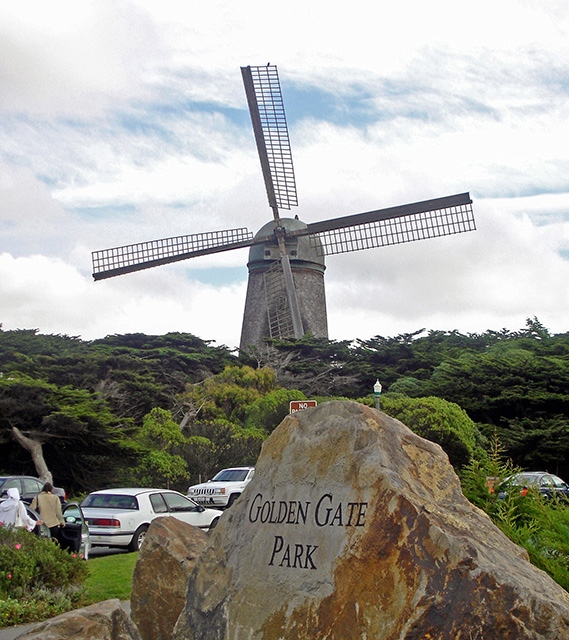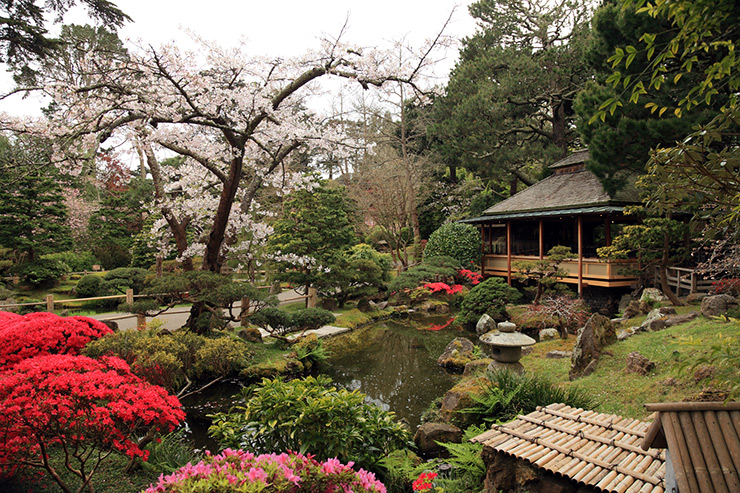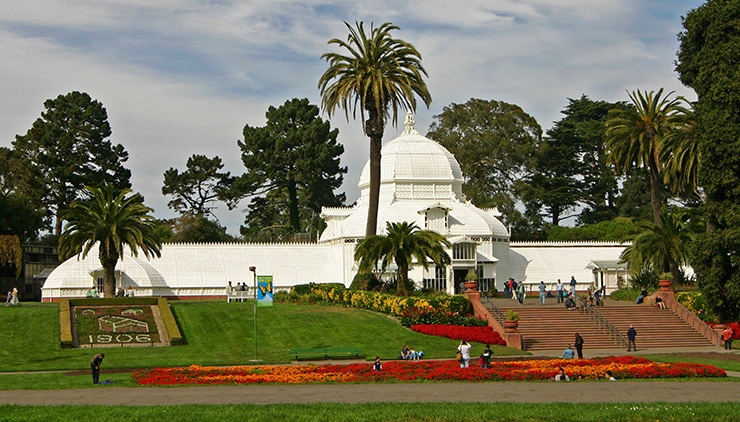
Golden Gate Park from above
Golden Gate Park
From nondescript sand dunes and shrubbery to a magnificently designed vision of public space, this beloved 1017-acre park is configured as a 3-mile by half mile rectangle. When you include the 8 blocks long Panhandle, Golden Gate Park spans half the width of San Francisco and all of its heart.
Nearly 14 million annual visitors make Golden Gate Park the third most visited city park in the United States, after Central Park in New York City and Lincoln Park in Chicago. It is the only large urban park in America to include Basketball Courts, Handball Courts, Baseball Fields, Track & Field, Tennis Courts, Dog Run, Bowling Greens, Japanese Tea Garden, waterfalls, conservatory, arboretum, buffalos, windmills, and fine restaurants. A 9-hole public golf course is thrown in for good measure. For pleasant exercise, consider the walking trail that starts at Stanyan & Fulton Streets, winding and changing elevation over 10-miles in route to the Pacific Ocean. Stroll past various picnic areas. Near one of them, your ears will lead you to the drum circle.
Wherever you travel in park, prepare to observe hummingbirds, herons, hawks, owls, ducks, warblers, woodpeckers, finches and many other bird species attracted to the utopian diversity of plants throughout the landscape. Thanks to attentive park maintenance, generous philanthropy and many volunteers, the park receives lots of TLC that accentuates a dazzling array of attractions.

Dutch Windmill, Golden Gate Park
Two Dutch Windmills of 75 feet height, once pumped irrigation water that helped transform the park’s western half from dunes into landscaped lawns and gardens. Beneath the North Windmill is Queen Wilhelmina Tulip Garden that sparkles in glorious bloom every Spring. I’ll never forget the time I took my 80 year old grandmother here. Her eyes glazed upon the restored North Windmill on JFK Drive. She was astonished at seeing something beautiful, inviting and unexpected. From that moment onwards, I became her favorite grandson.
Beach Chalet, opened in 1925, was originally designed as a restaurant and bathing facilities for ocean swimmers. As ocean swimming declined in popularity over the decades, the fortunes of this building declined. For many years it alternated between closing and only opening for private events. Then a public-private partnership restored its indoor murals and attracted a notable restauranteur. Today the two-level chalet challenges the nearby Cliff House for inventive cuisine and unobstructed sunset views of the Pacific Ocean. Take it from me, the chef’s filet mignon is flawless … some of the best I’ve tasted in America. And though it has a perfectly admirable micro-brewery, the restaurant is family-friendly too. Beers aren’t my strength, but I’m told by a friend who lives in the city, that the selection is solid.
As late as 1990, activity at the soccer fields was modest at best. Since the popularity of soccer in America has dramatically grown over the last 25 years, the fields are packed most days. A quaint surprise is the Buffalo Paddock, a friendly and safe home for this buffalo bison herd since 1899.
Spreckels Lake attracts remote-controlled boat owners of Model Yacht Club on the weekends. Like the owners, you’ll have a lot of fun watching electric-powered and sailboats. Membership is open to anyone with an interest in model yachting and power boating.

Couple row boating on Stow Lake, Golden Gate Park
Boathouse and Paddle Boat Rentals surround Stow Lake, the park’s biggest lake. You can paddle past an old stone bridge, a tall waterfall, and a Chinese pavilion. Even though the waterfall is man-made, it organically fits in to captures your imagination. More adventurous travelers climb Strawberry Hill, an island in the center of the lake. Strawberry Hill measures 429 feet above sea level. As the highest point in the park, it offers excellent views of surrounding communities, as well as distant views of Golden Gate Bridge, Bay Bridge and majestic Mount Tamalpais. While the lakefront attracts ducks who greet visitors hoping for a few crumbs, while turtles lounge on rocks and herons hunt for small fish. Like a dream sequence, Strawberry Hill attracts swallowtail and monarch butterflies. Its a good idea to bring bread crumbs, binoculars or camera.
The Japanese Tea Garden, originally developed for the 1894 World’s Fair, was designed by Baron Makoto Hagiwara, a wealthy landscape designer. It is the oldest Japanese Tea Garden in America. That temporary exhibit became a permanent feature afterwards and Hagiwara family increased the size of the gardens, and imported exotic animals and statues developed by a Master Shrine Builder in Japan. Today it is one of the most prized attractions in Golden Gate Park.
M.H. de Young Museum enjoyed a 2005 makeover whose architecture draws as much attention as its fine collections in American art, African Art, Oceanic Art, South American art, and Photography. When major international exhibits tour at the de Young, arrive early for underground parking. A hiding in plain sight treat is the deYoung’s 144-foot high observation deck offering Free panoramic views of San Francisco and both bridges.

Japanese Tea Garden, Golden Gate Park
Few parks in the world are as consistently colorful and fragrant as Golden Gate Park due to Strybing Arboretum and San Francisco’s moderate climate permitting a year-round growing season. Cast your eyes on the Japanese Cherry Tree and Plum Tree Blossoms, redwood grove, tulips, dahlias, and roses among the 8,000 varieties in its landscaped gardens. Also notice flora from distant Chile and Australia, a waterfowl pond full of geese and swans, and many other birds.
The Music Concourse hosts free concerts on Sundays during the summer and serves as a picnic spot year-round for visitors to California Academy of Sciences, de Young Museum and Japanese Tea Garden.
Breathtaking California Academy of Sciences, is easily one of America’s best science museums. Re-imagined, expanded and reopened in 2008, the energy-efficient architecture includes solar panels under a 2.5-acre living roof and features 1.7 million native plants. The interior sports a 4-story rainforest, Steinhart Aquarium, Phillipine Coral Reef, all-digital Planetarium, inventive Water Planet and Earthquake exhibits. More than 38,000 live animals call California Academy of Sciences home.
Sharon Art Studio is the city’s largest community art center, offering affordable classes in ceramics, glass, jewelry, drawing and watercolor for all ages. The Children’s Playground that has entertained generations of San Franciscans and since 1887 and the carousel built in 1914. Both playground and carousel underwent a major renovation and reopened in 2007 as the Koret Children’s Quarter. Kids make the climbing wall and rope climbing structure popular. Kezar Stadium was leveled and reimagined as a venue for track meets and occasionally, a track star in training.

Golden Gate Park Conservatory
Built in 1879, Conservatory of Flowers, an elegant Victorian structure built of wood and glass, is the oldest building in Golden Gate Park. It houses a living museum of rare aquatic and tropical plants, including a 100-year-old giant Imperial Philodendron and a world-renowned collection of orchids. Maybe its the abundant flora producing concentrated oxygen in this remarkable greenhouse, but whenever I enter, it feels like I’ve stepped into a dream sequence.
Whatever attraction, event or serendipity brings you here, Golden Gate Park will always make you leave your heart in San Francisco.
